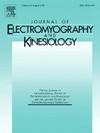肌腱过度使用模型对离体牛肌腱组织力学性能有不同的影响
IF 2.3
4区 医学
Q3 NEUROSCIENCES
引用次数: 0
摘要
肌腱病是一种发生在高负荷肌腱的过度使用损伤,导致功能下降和疼痛增加。目前的肌腱病变治疗产生不一致的结果,需要新的治疗方法。目前尚不清楚用于开发新疗法的肌腱病变模型是否能复制损伤的机械效应。我们的目的是比较两种已建立的肌腱病变模型-胶原酶注射和机械过载-在离体牛肌腱中的力学特性。将18根牛肌腱分为3组,分别为未损伤组、胶原酶注射组(0.5 mL胶原酶和0.5 mL纤维蛋白凝胶)组和机械过载组(拉伸加载/卸载5个循环)。对样品进行力学测试。计算刚度、失效时最大力和极限拉应力(UTS),然后使用单因素方差分析(1-way ANOVA)对各组进行比较,显著性设置为p <;0.05. 结果表明:机械过载组最大受力和UTS降低(402.1±232.3 N;9.1±5.3 MPa)与未损伤(1222.9±270.8 N;28.9±4.6 MPa)和胶原酶注射组(1309.0±242.1 N;25.0±8.2 MPa)(均p <;0.001)。各组间硬度无差异(p >;0.33)。结果表明,体外机械负荷比胶原酶注射更能反映肌腱病变的力学特性。本文章由计算机程序翻译,如有差异,请以英文原文为准。
Tendon overuse models have different effects on tissue mechanical properties in ex vivo bovine tendons
Tendinopathy is an overuse injury that occurs in high load bearing tendons, causing decreased function and increased pain. Current tendinopathy treatments produce inconsistent outcomes, creating a need for novel treatments. It is unclear whether current tendinopathy models used to develop new treatments replicate the mechanical effects of the injury. We aim to compare the mechanical properties of 2 established tendinopathy models – collagenase injection and mechanical overload − in ex vivo bovine tendons. Eighteen bovine tendons were split into 3 groups, including: uninjured, collagenase injection (0.5 mL collagenase and 0.5 mL fibrin gel), and mechanical overload (5 cycles of tensile loading/unloading). Mechanical testing of samples was performed. Stiffness, maximum force at failure, and ultimate tensile stress (UTS) were computed, then compared across groups using 1-way ANOVA with significance set at p < 0.05. Results showed maximum force and UTS were reduced for the mechanical overload group (402.1 ± 232.3 N; 9.1 ± 5.3 MPa) versus uninjured (1222.9 ± 270.8 N; 28.9 ± 4.6 MPa) and collagenase injection groups (1309.0 ± 242.1 N; 25.0 ± 8.2 MPa) (all p < 0.001). Stiffness was not different across groups (all p > 0.33). Findings suggest that ex vivo mechanical overload better represents the mechanical properties of tendinopathy than collagenase injection.
求助全文
通过发布文献求助,成功后即可免费获取论文全文。
去求助
来源期刊
CiteScore
4.70
自引率
8.00%
发文量
70
审稿时长
74 days
期刊介绍:
Journal of Electromyography & Kinesiology is the primary source for outstanding original articles on the study of human movement from muscle contraction via its motor units and sensory system to integrated motion through mechanical and electrical detection techniques.
As the official publication of the International Society of Electrophysiology and Kinesiology, the journal is dedicated to publishing the best work in all areas of electromyography and kinesiology, including: control of movement, muscle fatigue, muscle and nerve properties, joint biomechanics and electrical stimulation. Applications in rehabilitation, sports & exercise, motion analysis, ergonomics, alternative & complimentary medicine, measures of human performance and technical articles on electromyographic signal processing are welcome.

 求助内容:
求助内容: 应助结果提醒方式:
应助结果提醒方式:


